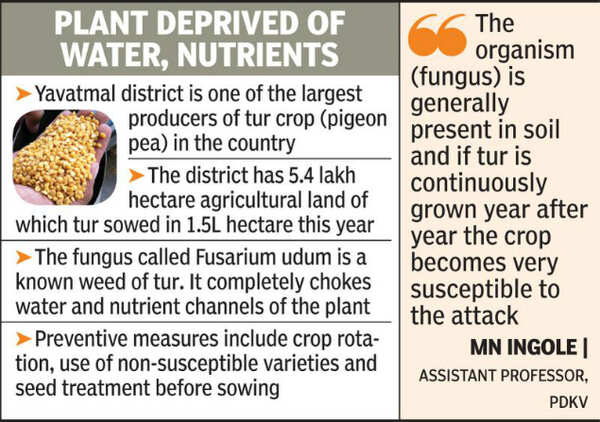- News
- City News
- nagpur News
- Fungus kills 20% tur crop in Yavatmal
Trending
This story is from December 8, 2018
Fungus kills 20% tur crop in Yavatmal

Representative image
NAGPUR: After cotton and soyabean crop failures, it’s now tur which has dealt a blow to Yavatmal farmers. Almost 20% of tur crop (pigeon pea) has been destroyed by a fungal attack in Yavatmal district, one of the largest producers of the commodity in the country, this year.
The fungus called Fusarium udum is a known weed of tur which is causing wilting of the crop. Not much can be done to save the crop as the fungus completely chokes water and nutrient channels of the plant.

Farmer Vijay Telange from Mohda village in Kelapur taluka of the district told TOI that almost all tur crop is wilting in the area.Farmers from Pusad taluka are also complaining the same. Treating seeds by applying fungicides can prevent damage to crops. “However, private seed companies are defrauding farmers. The companies treat just a sample of the entire seed stock for inspection and supply untreated seeds to a majority of farmers. This has been going on for years and a chain of companies is involved in this,” he said.
MN Ingole, assistant professor of pathology at Panjabrao Deshmukh Krishi Vidyapeeth (PDKV), told TOI that the organism (fungus) is generally present in soil and if tur is continuously grown year after year the crop becomes very susceptible to the attack. “The fungus enters the plant from soil through roots. But when it reaches the stem it chokes the vascular bundles (water and nutrient carrying tubes) completely. Thus, the supply of water and nutrients from the soil upwards is prevented causing wilting,” explained Ingole.
Besides using untreated seeds, the disease also comes in tur as farmers grow susceptible varieties without being aware of it. Farmers must follow crop rotation pattern and grow different crops in the same fields so that soil quality is maintained. But farmers in the region are so used to taking tur as a major crop along with cotton that they don’t think of any alternative, he said.
Ingole, listing the control measures, insisted on crop rotation, use of non-susceptible varieties and seed treatment before sowing. He said 2.5gm of Vita VX per kilogram of seeds should be used in treatment. As a bioagent Trichoderma, which too is a fungus, is used for seed treatment. Use of 4 gm of Trichoderma per kg seeds is good enough to prevent the disease. The seed replacement ratio also plays an important role in preventing the disease, he added.
While PDKV scientists explained about the disease, they have no data on the actual damage and the areas affected. Information could not be substantiated as all agriculture department officials in the district were busy in a sports meet.
With inputs from T O Abraham
The fungus called Fusarium udum is a known weed of tur which is causing wilting of the crop. Not much can be done to save the crop as the fungus completely chokes water and nutrient channels of the plant.

Farmer Vijay Telange from Mohda village in Kelapur taluka of the district told TOI that almost all tur crop is wilting in the area.Farmers from Pusad taluka are also complaining the same. Treating seeds by applying fungicides can prevent damage to crops. “However, private seed companies are defrauding farmers. The companies treat just a sample of the entire seed stock for inspection and supply untreated seeds to a majority of farmers. This has been going on for years and a chain of companies is involved in this,” he said.
The district has 5.4 lakh hectare agricultural land of which tur has been sowed in 1.5 lakh hectare this year.
MN Ingole, assistant professor of pathology at Panjabrao Deshmukh Krishi Vidyapeeth (PDKV), told TOI that the organism (fungus) is generally present in soil and if tur is continuously grown year after year the crop becomes very susceptible to the attack. “The fungus enters the plant from soil through roots. But when it reaches the stem it chokes the vascular bundles (water and nutrient carrying tubes) completely. Thus, the supply of water and nutrients from the soil upwards is prevented causing wilting,” explained Ingole.
Besides using untreated seeds, the disease also comes in tur as farmers grow susceptible varieties without being aware of it. Farmers must follow crop rotation pattern and grow different crops in the same fields so that soil quality is maintained. But farmers in the region are so used to taking tur as a major crop along with cotton that they don’t think of any alternative, he said.
Ingole, listing the control measures, insisted on crop rotation, use of non-susceptible varieties and seed treatment before sowing. He said 2.5gm of Vita VX per kilogram of seeds should be used in treatment. As a bioagent Trichoderma, which too is a fungus, is used for seed treatment. Use of 4 gm of Trichoderma per kg seeds is good enough to prevent the disease. The seed replacement ratio also plays an important role in preventing the disease, he added.
While PDKV scientists explained about the disease, they have no data on the actual damage and the areas affected. Information could not be substantiated as all agriculture department officials in the district were busy in a sports meet.
With inputs from T O Abraham
End of Article
FOLLOW US ON SOCIAL MEDIA










